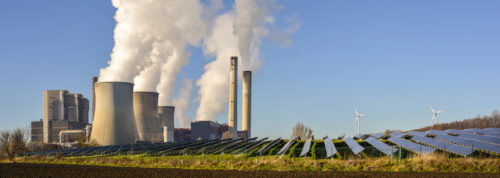
New Power Plant Standards Preserve Reliable, Affordable Electricity
A new EPA policy will diversify electricity sources, leading to a cleaner energy future.
On Thursday, May 11, the Environmental Protection Agency released new standards for power plants that will help accelerate the urgent need to transition to clean energy. We know that to meet climate goals, we will need to reduce the emissions from fossil-fuel-fired power plants, and this new standard is a major step in the right direction. This standard will further support a transition already underway that is being driven by the compelling economics of clean energy, ushering in a reliable, affordable electricity system for all.
The EPA’s action comes as our relationship as a society with fossil fuels must change. This standard will help deliver on the need to continue to innovate and grow clean energy alternatives that meet performance requirements for reliability, affordability, resilience, security, and the environment, delivering equal or better outcomes than the current emissions-intensive system.
Today, there are many options for cost-effectively supporting grid reliability without relying on uncontrolled fossil fuel power plants — plants that can fail when they are needed most during extreme weather, and cause outsized health burdens on disadvantaged communities. Grid operators already have significant experience in lowering costs and supporting reliability with carbon-free resources. Three opportunities in particular deserve renewed attention and emphasis in light of the EPA’s new standards:
1. Prioritizing cost-effective “clean energy portfolios”
Since 2018, RMI analysis has shown that portfolios of carbon-free resources can be more affordable and just as reliable as gas-fired power plants, and the experience of leading utilities provides real-world evidence supporting this analysis. The Inflation Reduction Act (IRA), the climate bill passed in 2022, provides new incentives for renewable energy, storage, and other carbon-free energy resources, further increasing the cost benefits of transitioning to clean energy. RMI showed that the IRA makes clean energy portfolios cheaper than 90 percent or more of new proposed gas plants.
Policymakers and regulators can support utilities in finding cost-effective solutions for reliability needs by requiring all-source, competitive procurement that can level the playing field between all types of resources. Leading utilities that use competitive, all-source procurement, and especially those that have updated their processes since the IRA was passed, have already found that new gas plants make less financial sense than a portfolio of carbon-free energy resources.
2. Unlocking interconnection queues and new transmission investment
Utilities and other investors have plans to invest more than a trillion dollars in new carbon-free resources including wind, solar, and battery storage projects that can go a long way to supporting and improving grid reliability. But these new investments are being held up by cumbersome, outdated processes that can delay connecting a project to the grid by years, and sometimes by technical limitations on the current electricity transmission networks. These delays can lead to cost increases and project cancelations that ultimately raise prices for electricity customers and limit the reliability benefits of new investment.
Policymakers and regulators can help utilities and project investors remove bottlenecks to new carbon-free resources by:
- Addressing structural challenges to interconnection queue processes to speed up studies and allow more resources to be built faster, and contribute to meeting reliability needs;
- Creating market opportunities for grid-enhancing technologies to improve interconnection capacity for new wind, solar, and battery projects; and
- Promoting solutions for new, interregional transmission that can improve access to low-cost renewable energy across the country, which can provide major benefits for reliability during extreme weather events.
3. Leveraging emerging technologies
While commercial clean energy technologies — including virtual power plants (VPPs) composed of small-scale, distributed energy resources as well as utility-scale solar, wind, and storage — can cost-effectively meet today’s grid reliability needs, there are many emerging technologies that may play a role in a future, deeply decarbonized electricity grid that can reliably power an increasingly electrified US economy.
The economic competitiveness of many of these technologies is starting to come into view. The US Department of Energy, in reports released in March, assessed many emerging technologies in terms of cost-effectiveness, land use, capability to support system-level grid reliability, and more. The reports highlighted requirements and opportunities for several technologies to play a role in a decarbonized grid. Several of these technologies already have commercial projects that may serve as near-term proof points for their ability to cost-effectively support grid reliability in the long run, including geothermal, long-duration storage, and gas with carbon capture and storage.
Which of these emerging technologies, if any, may eventually play a significant role in a decarbonized power system remains to be seen. But regulators and policymakers can act today to level the playing field for already-commercial technologies, such as wind, solar, battery storage, and VPPs, to cost-effectively meet the current reliability needs of a grid without reliance on new and expensive fossil plants that lack adequate emissions safeguards. Looking ahead, there are clear opportunities for emerging technologies to be the centerpiece of our clean energy economy, and regulators and policymakers can support utilities in evaluating these options as they navigate the energy transition.
